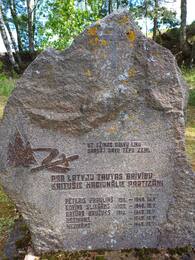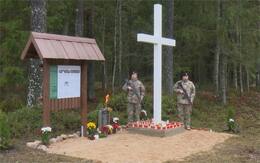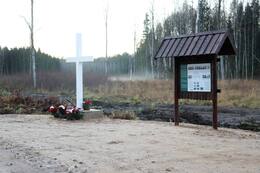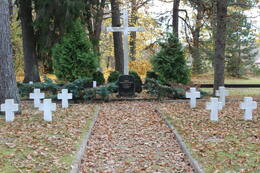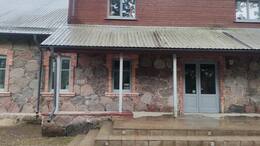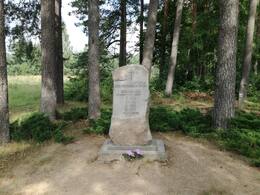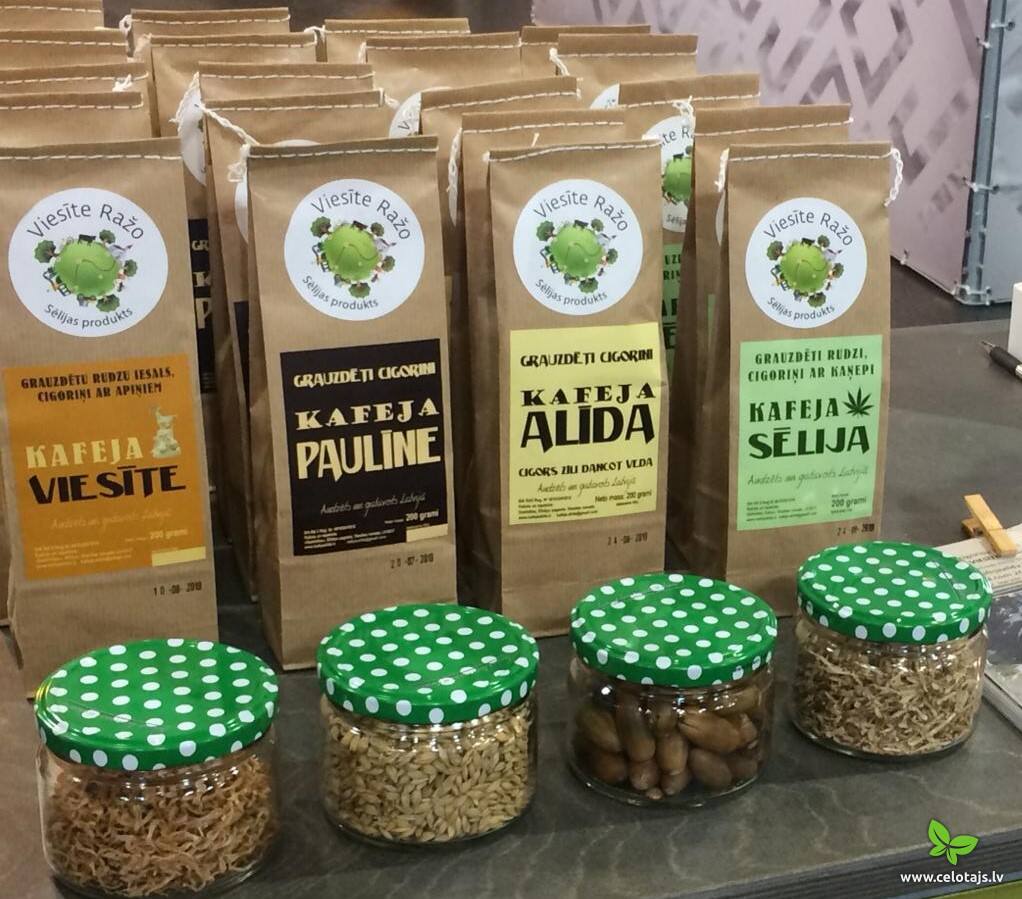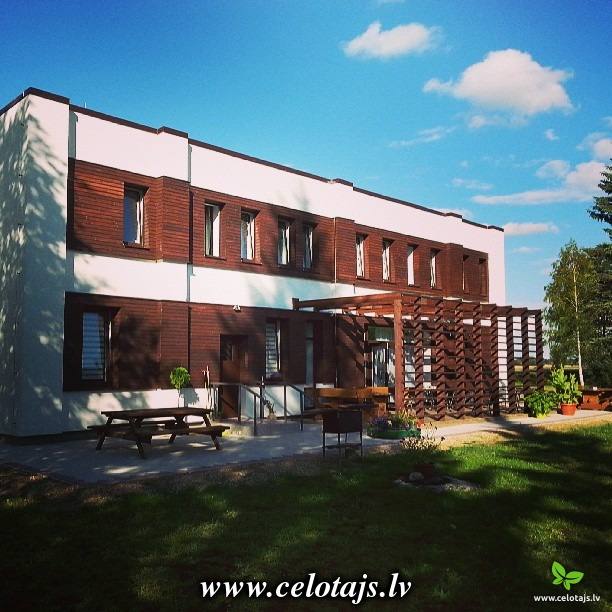Ginkluotas pasipriešinimas sovietų okupacijai Sėloje
Diena 1.
48 km
Kalno parapija - Aknīste - Susēja
Praktinė informacija
* Atstumas automobiliu: ~48 km. Dauguma kelių asfaltuoti, tačiau į atokesnes vietas galima patekti žvyrkeliais.
* Maršrute yra labai mažai vietų papietauti ir pavakarieniauti. Galite užsisakyti maistą iš anksto arba atsinešti savo maisto pietums.
* Buvusius Susėjos parapijos namus galima aplankyti iš anksto susitarus. SUSēJA veikia kaip meno rezidencija, kurioje kartą per metus vyksta „Sanssouci“ festivalis.
* Atminimo ženklus galima apžiūrėti bet kuriuo metu
* LIEPAS siūlo tik banketų aptarnavimą ir apgyvendinimą, neveikia kaip kasdieninė kavinė.
* Maršrutas yra skirtas kaip vadovas – kaip optimaliai keliauti po regioną ar šalį, siekiant pažinti jos karinį paveldą;
* Keliautojas planuoja, kiek iš rekomenduojamų objektų ir vietų gali apžiūrėti per vieną dieną;
* Prieš kelionę reikėtų pasitikrinti lankytinų vietų (muziejų, kolekcijų, įtvirtinimų ir kt.) darbo laiką;
* Vietose, kur būtina išankstinė rezervacija (vietiniai gidai, privačios kolekcijos ir kt.), apsilankymą būtina užsisakyti, nurodant datą ir laiką. Jei kelionė atšaukiama, apie tai reikia informuoti užsakytų vietų atstovus;
* Apgyvendinimą būtina užsisakyti iš anksto. Vasaros sezonu apgyvendinimas gali būti neprieinamas, ypač pajūryje. Kai kurios maitinimo įstaigos žiemos sezonu gali nedirbti;
* Kelionei rinkitės ne tik vasarą, bet ir kitus metų laikus;
* Apsilankykite turizmo informacijos centruose, kur galite gauti papildomos informacijos, brošiūrų ir žemėlapių.
Lankytinos vietos
P. Praulinio nacionalinio partizanų būrio narių atminimo vieta ir bunkerio vieta
Pēteris Prauliņš (1911–1949) Biržų parapijos nacionalinis partizanų būrelis priklausė Mārtiņa Pokļevinskio (1902–1951) vadovaujamai grupei. Grupė vykdė keletą partizaninių akcijų, kurių metu buvo baudžiami sovietų kolaborantai, rekvizuojamas okupacinės valdžios ekonominių įstaigų maistas ir turtas. P. Praulinio grupės partizanai nesilaikė pakankamo sąmokslo principo, daugelis asmenų lankydavosi jų gyvenvietėje, o tai sudarė sąlygas išdavystei. Karinės patirties stoka buvo vienas iš partizaninio ginkluoto judėjimo trūkumų.
P. Praulinio partizanų grupė Kalnos miške Biržų valsčiuje buvo sunaikinta 1949 m. gegužės 16 d. Latvijos SSR Valstybės saugumo ministerijos operacijos, kurioje dalyvavo ir kariniai daliniai, metu. Miško broliai buvo įsirengę gerai užmaskuotą bunkerį su perimetro gynyba, kuris buvo įsikūręs nenustatytame aukštyje pelkėtoje vietovėje. Partizanai mažiausiai 40 minučių įnirtingai priešinosi Čekos kariuomenei, tačiau krito visa grupė: Pēteris Prauliņš, Artūras Bružukas, Jānis Kalvāns, Edvīns Slikšāns ir Francis Skromanis. Sušaudyti miško broliai buvo numesti netoli valsčiaus namų, tačiau jų palaikai vėliau buvo palaidoti netoliese esančiuose žvyrduobėse. Sunkiai sužeista buvo Irma Bružuka, kuri buvo paimta į nelaisvę ir mirė gegužės 17 d. Jekabpilio ligoninėje. Ji buvo palaidota už kapinių ribų, tačiau, kai kapinės buvo išplėstos po Latvijos nepriklausomybės atkūrimo, ant jos kapo buvo pastatytas paminklas.
1998 m. lapkritį buvo pašventintas atminimo akmuo P. Praulinio grupės partizanams Kalnos valsčiuje. P. Praulinio bunkerio vieta yra Vidsalos 99-ojo kvartalo 4 sekcijoje, Kalnos valsčiuje. Akmuo, ant kurio sėdėjo P. Praulinis, yra išsaugotas.
J. Indānso, J. Grāvelsono ir M. Pokļevinskio nacionalinių partizanų grupių narių atminimo vieta
Lačplėsio dieną – 2019 m. lapkričio 11 d. – buvo atidarytas Indano-Grāvelsono nacionalinių partizanų grupės informacinis stendas ir atminimo vieta Kalnos valsčiuje, Jekabpilio rajone, Sūpės purvo apylinkėse. Jo atidaryme dalyvavo Jekabpilio ir Viesytės regionų atstovai, buvęs nacionalinis partizanas H. Miezīte, istorikas H. Bruņinieks, taip pat svečiai iš Lietuvos ir kiti susidomėję asmenys. Atminimo vieta ir stendas yra netoli Sūpės purvo, kuris siejamas su nacionalinių partizanų gyvenviečių ir mūšių vietomis. Giliau miške taip pat buvo Indano-Grāvelsono grupės bunkeris.
Po Latvijos gyventojų deportacijų 1949 m. kovo 25 d. buvo sunaikinta nacionalinių partizanų aprūpinimo sistema. Nuo 1949 m. vasaros iki 1952 m. vidurio nacionalinis partizanų judėjimas Aknystės, Saukos, Elkšnių, Biržų ir Viesytės apylinkėse išgyveno nuosmukį, nes kentėjo nuo etninio valymo ir reguliarių sovietų armijos bei saugumo institucijų kontrpuolimų. Janio Indano ir Janio Grāvelsono nacionalinių partizanų grupės įsikūrimas Elkšnių miške 1949–1950 m. žiemą turėjo labai rimtą, tuo metu nebūdingą gynybos sistemą, kurios 1950-aisiais nebuvo niekur kitur Latvijoje ar kaimyninėje šalyje Lietuvoje. Indano-Grāvelsono grupės bunkeryje buvo specialiai sukurti perimetro gynybos apkasai ir patrankų lizdai. Greta partizanų karinio pasirengimo paaukoti savo gyvybes kovoje su priešu, galima kalbėti ir apie jų ypatingą tapatybę, kuri pasireiškė ir kitų šeimos narių įsitraukimu į nacionalinių partizanų gretas.
Jungtinę Indano-Grāvelsonų partizanų grupę sudarė 12 žmonių, tarp kurių buvo penkios moterys ir vienas Lietuvos partizanas: Jānis Indāns, Jānis Edvards Grāvelsons, Alma Grāvelsone, Pēteris Indāns, Kristīne Indāne, Milda Ārija Indāne, Vasilijs Sokolovs, Voldemārs Otto Sātnieks, Jonda Sātnieks, Jānis Ķepiņš. Žukauskis. Paskutinis jų mūšis įvyko 1950 metų vasario 25 dieną Elkšnių girioje, kai mūšyje su neproporcingai stipriomis jėgomis krito 11 partizanų. Išgyveno tik Hilda Vietniece (Miezīte), kuri buvo sugauta ir vėliau šešerius metus praleido kalėjime Gulago lageriuose.
Atminimo vieta 1945 m. vasario 13 d. nacionalinių partizanų mūšio vietoje Kalnos parapijos Deimantų miške
Memorialinė vieta buvo sukurta rajoniniame kelyje P74 Siliņi – Aknīste, 12 kilometrų nuo Aknīstės, pasukus į Latvijos valstybinį mišką „Žagari kelias“.
Jau 1944 m. vasaros pabaigoje didžiulis Elkškių valsčiaus šiaurinės dalies miškų masyvas tapo žmonių, besiruošiančių ginkluotai kovai su sovietų okupacine valdžia, susibūrimo vieta. 1944 m. pabaigoje Aknystės apylinkėse pradėjo kurtis nacionalinių partizanų grupės. Tinkama vieta partizanų stovyklai įkurti buvo Deimantinis miškas , esantis Elkškių didžiojo miško pietiniame pakraštyje, netoli Aknystės Didžiosios pelkės. Ten, mažiau nei 10 kilometrų nuo Aknystės valsčiaus, nacionaliniai partizanai įrengė tris žiemos bunkerius žiemojimui. Miške susirinkusių vyrų susisiekimas buvo užtikrinamas padedant netoliese esančių namų – Baltimorės, Gargrodžių, Lyčių, Priedžių, Krūmų – ir kitų namų gyventojams, kaimynams bei partizanams.
Partizanų mūšis su Latvijos SSR Valstybės saugumo ministerijos kareiviais Deimantų miške įvyko 1945 m. vasario 13 d. Čekistai, paėmę įkaitus, juos nustūmė į priekį, kad atidengtų partizanų bunkerius. Miško broliai, pamatę pavojų, atidengė ugnį, negailėdami įkaitų. Mūšyje žuvo 10 sovietų okupacinių kariuomenės atstovų, aštuoni nacionaliniai partizanai ir keturi įkaitai. Nepaisant miško brolių nuostolių, čekistams nepavyko užimti partizanų bunkerių. Išlikę partizanai palaukė sutemų ir paliko gyvenvietę. Mūšyje sužeisti čekistų kareiviai, dejuodami, negalėjo palikti mūšio lauko. Po šio mūšio, kurį galima laikyti pirmuoju miško brolių „kovos krikštu“, partizanai jautėsi kaip broliai, o šautuvas atrodė brangesnis už viską, kaip vienintelis patikimas gelbėtojas.
Baltasis kryžius ir informacinis stendas Deimantų miške buvo įrengti Lačplėsio dieną – 2022 m. lapkričio 11 d. Atminimo vietos sukūrimą parėmė Jekabpilio regioninė valdžia, asociacija „Tēvzemes sargi“ ir Latvijos valstybiniai miškai. Informacinio stendo turinio autorius yra istorikas Haraldas Bruņinieksas.
Sėlijos nacionalinių partizanų brolių kapinės
Sėlijos nacionalinių partizanų brolių kapinės buvo atidarytos 2004 m. spalio 30 d., remiant Latvijos gynybos ministerijai ir Aknīstės savivaldybei. Jose palaidoti 1949 m. gruodžio 19 d. mūšyje Kalnos parapijos Dimantų miške žuvę partizanai: Albertas Karankevičius (1914–1949), Vilis Tunkelsas (1911–1949), Arnoldas Tunkelsas (1926–1949), Osvaldas Tunkelsas (1929–1949), Ēvaldas Kundzanas (1927–1949).
2005 m. čia buvo perlaidoti ir 1945 m. vasario 13 d. mūšyje Elkšnių girioje kritę partizanai: Juris Alfreds Voldemārs Lācis (1908-1945), Eduards Kaminskis (1910-1945), Albertas Mežaraups (1945 m. Alberts Mežaraups, 1945 m. (1915-1945), Antons Bružiks (1911-1945), Jānis Britāns (1926-1945) ir vienas nežinomas. Bendrosiose kapinėse taip pat yra sovietų okupacinės valdžios įkaitais paimtų ir mūšio metu žuvusių Martos Mežaraupės (1907–1945), Alberto Lācio (1902–1945), Jurio Resnīčio (1901–1945) ir Pēterio Bitės (1907–1945) palaikai, taip pat žuvusio Indano-Grāvelsono grupės partizano Voldemaro Otto Sātniekas (1911–1950). Aknīstės brolių kapinėse taip pat yra paminklas Aknīstės kuopos nacionaliniam partizanui Alfredui Silaraupui (1925–1946), žuvusiam per Čekos operaciją 1946 m. liepos 30 d. siaurajame geležinkelyje Elkšnių miške.
Sėlijos nacionalinių partizanų brolių kapinėse pastatyto Baltojo kryžiaus papėdėje stovi juodo granito stela su Latvijos nacionalinių partizanų asociacijos emblema ir po ja iškaltu tekstu „Sėlijos nacionaliniams partizanams. Jūs paaukojote savo gyvybes už Latviją kovoje su komunistiniu okupaciniu režimu 1944–1954 m.“ Kapinėse taip pat yra paminklinis akmuo su užrašu „Yra ašarų, kurios bus išlietos tyloje. Yra randų, kurie neužgis užgijus“, kurį Stanislava Šadurska pastatė Atgimimo pradžioje netoli duobės, kurioje čekistai palaidojo dieną prieš tai, 1955 m. vasario 14 d., žuvusius nacionalinius partizanus ir įkaitus.
Buvę Susėjos parapijos namai, nacionalinių partizanų išpuolio vieta 1945 m. liepos 7 d.
Šiandien buvusiuose Susėjos parapijos namuose įsikūręs Sanssouci rezidencijų centras. Pastato fasade vis dar matyti nacionalinių partizanų kulkų palikti pėdsakai 1945 m. liepos 7 d. puolimo metu.
Buvę Susėjos parapijos namai, tuo metu veikę kaip sovietų okupacinės valdžios vietinis vykdomasis komitetas, 1945 m. liepos 7 d. nukentėjo nuo Sėlijos nacionalinių partizanų išpuolio. Išpuolis prieš Susėjos vykdomąjį komitetą buvo platesnės nacionalinių partizanų kampanijos dalis ir vyko tuo pačiu metu kaip ir išpuoliai prieš Vilkupės sviesto fabriką bei naikintojo Kaunacko namą.
Susėjos nacionalinių partizanų grupės vado Alberto Kaminskio (1920–1946) nurodymu miško broliai turėjo sunaikinti vietos vykdomojo komiteto apsaugą, paimti ginklus, milicijos uniformas, dokumentus ir sugadinti telefono ryšį. Susėjos vykdomojo komiteto puolime dalyvavo apie 17 miško brolių, vadovaujamų Lietuvos partizanų vado Jozo Kuveikio. Mūšis truko 15–20 minučių, susišaudymo metu žuvo vienas Lietuvos partizanas, o kitoje pusėje – naikintojų bataliono Jānio Kakarano kovotojas. Susišaudymo metu buvo išdaužti vykdomojo komiteto langai ir apgadintas telefonas.
Antrasis išpuolis prieš Susėjos vykdomąjį komitetą įvyko 1945 m. liepos 16 d., kai vyko užsitęsęs susišaudymas tarp „Miško brolių“ ir naikintojų bataliono kovotojų, kurie buvo pasislėpę Vykdomojo komiteto pastate. Mūšio metu pastariesiems į pagalbą atėjo grupė sovietų kareivių, kurie iš flango atidengė kulkosvaidžių ugnį ir privertė partizanus trauktis. Mūšyje žuvo mažiausiai penki „Miško broliai“ ir penki naikintuvai. Išpuoliai prieš šį okupacinės valdžios administracinį objektą patvirtino partizaninio karo ginkluoto pasipriešinimo pobūdį ir buvo įspėjimas apie žmonių pasipriešinimą sovietų okupacinei valdžiai.
Susėjos nacionalinių partizanų paminklas
Susėjos nacionalinis partizanų būrys buvo suformuotas iš mažesnių suskaidytų miško brolijos grupių, nes iš pradžių nebuvo vadovo, kuris galėtų jas suvienyti. Trumpą laiką Artūras Grābeklis bandė koordinuoti Susėjos partizanų, o vėliau ir Markejaus Gorovniovo, žuvusio 1945 m. žiemą, veiklą. Susėjos nacionalinis partizanų būrys buvo sustiprintas po to, kai po visuotinės Vokietijos kapituliacijos į Kuršą, Sėliją, atvyko buvęs legionierius Albertas Kaminskis. Jis įvedė griežtesnę drausmę ir suvienijo mažesnes grupes bendrai kovai su sovietų okupacine valdžia. Taip pat buvo bendradarbiaujama su miško brolijos grupėmis iš netoliese esančių parapijų ir vietovių, ypač su Gārsenės grupe ir Lietuvos partizanais, kurie buvo įsikūrę Lietuvos ir Latvijos pasienyje.
Ankstyvaisiais ginkluoto judėjimo etapais akivaizdu, kad miško broliai nebuvo pasiruošę puolimams, negalėjo užimti nei Kaunackų sodybos, nei įsilaužti į Susėjos vykdomojo komiteto pastatą. Partizanai patyrė nuostolių ir ilgai negalėjo pasipriešinti Čekos kariuomenei, o pagrindinis kovos metodas buvo galvoti apie atsitraukimą laiku. Taip pat buvo problemų dėl partizanų aprūpinimo. Nepaisant esamų sunkumų, Susėjos nacionalinis partizanų būrys pirmaisiais pokario metais vis dar sugebėjo aktyviai priešintis sovietų okupacinei valdžiai. Ši partizanų grupė nustojo egzistavusi po jos vado A. Kaminskio žlugimo 1946 m. gegužės 14 d. Po to sekė ir kelių miško brolių legalizavimas, taip pat prisijungimas prie kitų partizanų grupių.
Paminklas Susėjos kuopos nacionaliniams partizanams atidengtas 1997 m. lapkričio 11 d. Sėlijos nacionalinių partizanų istorijos tyrinėtojo Gunāro Blūzmo iniciatyva. Šalia žuvusių Susėjos nacionalinių partizanų vardų, grubiai apdirbtame riedulyje po kryžiaus ženklu iškaltas tekstas: „Ant ežio galvos įsakiau tau saugoti tėvo žemę“. Paminkle minimi 1945 m. liepos 16 d. užpuolus Susėjos vykdomąjį komitetą žuvusieji – Jānis Grābeklis (1923-1945), Ādolfas Rācenis (1919-1945), Broņislavs-Arvīds Bīriņš (1919-1945), vėlesnis vardas9 (Edgars450-1) ir Edgars45. buvo pridėti nužudytieji Lina Kaminska (1917-1945) ir Albertas Kaminskas (1920-1946). Ant paminklo trūksta Arnoldo Dombrovskio (1923-1945) ir kitų Susėjos tautinių partizanų grupėse veikusių, 1945-1946 metais kritusių nacionalinių partizanų pavardžių.
*********************************************************************
Kaimo keliautojo turistinis maršrutas po Sėliją siūlo išsamią santrauką su papildomomis lankytinomis vietomis :
https://site-244605.mozfiles.com/files/244605/ Selija-LAT-3.pdf
Vietos pavalgyti
Kafeja Alīda
Aromatic coffee is produced here from chicory and on the basis of ancient recipes from grandma Alīda. All of the ingredients come from surrounding fields and forests. Roasted chicory coffee PAULĪNE (rye, chicory, carrots, acorns); roasted rye, chicory, and hemp coffee SĒLIJA (rye, chicory, carrots, hemp leaves); rye malt, chicory, and hop coffee VIESĪTE (rye malt grains, chicory, hops). Produce can be purchased.The owner will offer you a tour, during which you will be able to taste and buy her coffee.
Kavinė „Kalniņa“ siūlo aukštos kokybės patiekalus, užkandžius, įvairius gėrimus ir kokteilius.
Siūlomi tiek bistro stiliaus švediškas stalas, tiek iš anksto paruoštos porcijos.
Taip pat, iš anksto susitarus, teikiamas grupių maitinimas.
https://visit.jekabpils.lv/lv/objekti/paliec/edinasana/vieta/kafejnica-kalnina-akniste/
https://www.facebook.com/kafejnicakalnina
Vietos apsistoti
LIEPAS
Guest house Liepas offers four rooms - two comfort (with WC, shower, TV), two with shared WC and shower. There is a spacious balcony, lobby with seating area, TV, Novus table, 24/7 Tea table. Catering in the ground floor cafe. Please arrange breakfast and dinner at the time of booking.
Gārsenės pilies nakvynės namuose siūlomas apgyvendinimas tiek lovose, tiek su čiužiniais, o kambarių talpa taip pat labai įvairi – dviviečiai, keturviečiai, šešiaviečiai ir kt.
Iš viso pilyje vienu metu gali apsistoti 45 svečiai lovose ir 37 svečiai ant čiužinių.
Visi svečiai gali naudotis bendrais dušais, tualetais ir virtuvėle. Pilies parke galima nakvoti palapinėse.
http://www.garsenespils.lv/naksnosana/
***
Poilsio kompleksas „Kalniņa“ siūlo platų svetingumo paslaugų spektrą: viešbutį, kavinę, modernų SPA kompleksą ir sporto salę. Taip pat yra didelė lauko poilsio zona su beveik hektaro ploto tvenkiniu, įsikūrusi vaizdingoje kalvų apsuptoje vietovėje.
Viešbutyje yra septyni miegamieji ir iš viso 32 lovos.
https://visit.jekabpils.lv/lv/objekti/paliec/naktsmitnes/vieta/atputas-komplekss-kalnina-/




